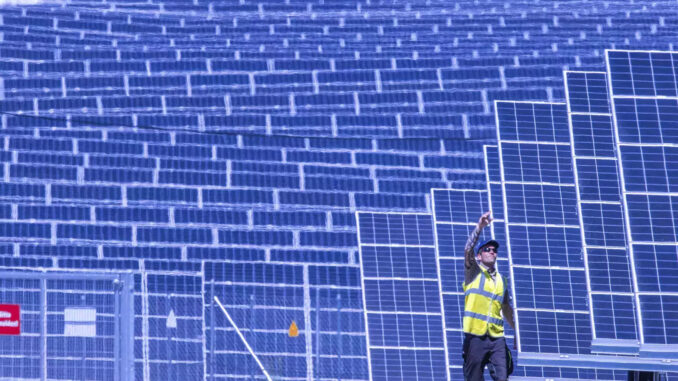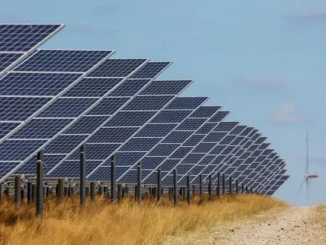
With the rapid increase in India’s solar energy capacity addition, there is a considerable amount of solar photovoltaic (PV) waste that is already being generated and is expected to grow in the coming decades, according to industry analysts.
A preliminary analysis by the Council on Energy, Environment and Water (CEEW) estimated 1,359 tonnes of waste by the end of financial year 2020-21 from the current 40 gigawatt (GW) solar capacity.
“Interestingly, this corresponds to a ‘regular loss scenario’, where waste is created from the stipulated end-of-life loss. The entire capacity would retire in 2046 and the cumulative waste created would be about 2.6 million tonnes,” Akanksha Tyagi, research analyst, CEEW, told ETEnergyWorld.
Solar panels have a useful life of 25 years and with rapid technological improvements, a lot of modules are likely to be replaced before the end of their lifespan, ultimately worsening the problem.
However, India’s installed solar capacity is still young, as of 31 January, 2021, the total installed capacity of solar power stood at 38,794 MW.
Sangeetha Suresh, senior manager – consulting, Bridge to India, said that the annual PV waste volume in India was expected to grow to 200,000 tonnes by 2030 and about 1.8 million tonnes by 2050.
“While substantial waste volumes will only begin accumulating from 2025 onwards, it is imperative to plan ahead to ensure safe and economically viable means of its management,” she added.
The renewable energy ministry is drafting a safe disposal policy for solar modules.
According to industry experts, there has not been any monumental efforts towards managing solar waste in India. There have been tentative steps taken by the ministry of new and renewable energy and the ministry of environment, forest and climate change but an effective policy framework along the lines of European standards is yet to be developed.
“So far, very little has been done in the absence of clear recycling policy and environmental standards. PV waste is not even covered under any current regulation covering hazardous waste or solid waste management… In the absence of such a policy, there are no specialist processing facilities for treating PV waste,” said Suresh.
The Ministry of New and Renewable Energy has started drafting a policy specifically for the safe disposal of solar modules on which consultations will be done with the Ministry of Environmental, Forest and Climate Change. Later, it will be opened for stakeholders’ discussions to incorporate best practices and research inputs from global experts.
A PV module is made up of glass, metal, silicon and polymer fractions. Glass and aluminium, together constitute about 80 per cent of total weight and are non-hazardous. However, other materials including polymers, metals, metallic compounds and alloys are potentially hazardous.
According to a report by Bridge to India, PV module recycling is still not commercially viable. Total estimated cost including transportation can vary between $400-600 per tonne — far exceeding the value of the recovered material.
It added that the waste is usually sent to laminated glass and metal recyclers that recover 70-80 per cent of the material by weight. Advanced recycling technologies can potentially push this up to 92 per cent.
Experts ask whether there are enough incentives in place to encourage renewable energy companies to go for recycling, as the cost is prohibitive particularly in view of commercial pressures being faced by the sector.
“Recycling and disposal of solar modules has a potential of becoming a bigger problem… There will certainly be a time when millions of obsolete solar modules will be ready for disposal and recycling after completing their useful life of 25 years,” said Pinaki Bhattachaya, chief executive officer and managing director, Amp Energy India.
He said that the government must plan and implement a robust recycling policy specially for solar modules.
According to Rashmi Shringi, vice-president, operations and maintenance, Amplus Solar, since the quantum of e-waste from solar modules is very low compared to other sources of e-waste, it has not become a mainstream issue.
“By 2040, the installations after 2010 will start reaching end-of-life cycle and before that the e-waste is expected to be of order of few hundred kilo tonnes till 2030, and only after 2040 the gigawatt scales of waste will become an issue,” added Shringi.
According to a report by TERI and WRI, in most of the central bidding documents the responsibility for handling and disposing of PV waste rests on the developers, as per the E-waste (Management and Handling) Rules, 2016. These rules, however, make no mention of the solar panel waste. The Hazardous and Other Wastes (Management and Transboundary Movement) Rules, 2016 also do not specify details regarding solar cells and modules.
According to industry experts, the primary onus is with the government to set up an appropriate regulatory framework to address this issue.
“Policymakers should establish a mandatory approach, outlining the responsible actors and annual targets for collection, recycling, and recovery. Second, developers should adopt second-life use of damaged or sub-performance modules. Third, the solar industry should invest in research around developing advanced recycling technologies with improved material recovery,” said CEEW’s Tyagi.
She further added that policymakers can introduce incentives based on the targets achieved by the producers and sellers such as green certifications.
Apart from this, mandating and promoting use of sustainable module design and materials, and specifying liability and responsibility of each stakeholder for waste management and treatment are some other ways to contain the problem of solar PV waste.



